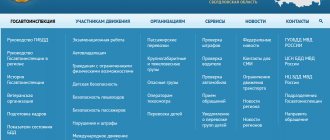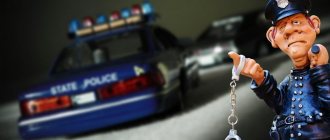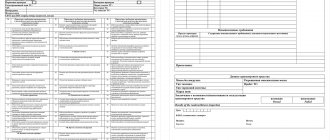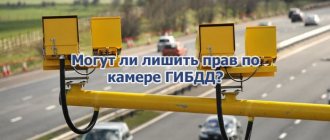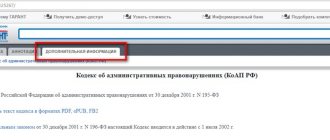Who is responsible for traffic police fines for legal entities?
A fine can be issued to the driver or the owner - in the case of a company car, this is a legal entity. A fine is possible even if the tenant or hired driver violated the rules.
Entity. Fines for violations of rules committed in a company car are most often issued to the company. This is due to the fact that most violations are recorded by a camera, but it does not know who is driving, and the fine is tied to the owner.
Fines for a legal entity for violating traffic rules are the highest, they are measured in tens and hundreds of thousands of rubles. In order not to pay a large amount, the organization has the right to challenge the fine and identify the real offender or deduct the fine from the employee’s salary. There are exceptions when this is prohibited:
- force majeure circumstances, such as a collision of several vehicles in the same lane;
- extreme necessity, for example when the driver was trying to avoid a rockfall.
A driver driving a company car may receive a fine personally if the car is stopped by a traffic police officer. The inspector will record the violation and enter the license number into the protocol - the decision will be issued to the individual.
Official of the organization . The Code of Administrative Offenses contains more than 20 fines that can be imposed on an official - for example, on the person responsible for releasing cars onto the line. As a rule, such fines are lower than for legal entities. Among them:
- release of a machine without registration, technical inspection or with malfunctions;
- allowing a drunk driver or a person without a license to drive;
- installation of false license plates, illegal flashing lights;
- driving a heavy truck with violations;
- violation of the rules for transporting children.
The most important thing you need to know about imposing penalties for legal entities!
So, the first thing you need to know is that a legal entity is subject to the same traffic police fines as drivers, if the organization is the culprit.
However, for example, in any case, only the driver of the vehicle will be prosecuted for not wearing a seat belt - a fine of 1,000 rubles. But for fake license plates, for example, a driver will be prosecuted for driving with such license plates (deprivation of a driver’s license), and the legal entity will be punished separately with a fine of up to half a million rubles.
In general, the organization provides the following rules for imposing penalties for violations of traffic rules and other regulations.
- If a specific article of the Administrative Code does not contain a separate fine for a legal entity, this does not mean that punishment will not follow. For example, a sanction for speeding will be assigned to the organization. Another thing is that the amount of the fine in this case will be standard - from 500 to 5,000 rubles (Article 2.10 of the Code of Administrative Offenses of the Russian Federation).
- If an article of the Code provides only for the deprivation of rights, then only drivers are prosecuted under it. For example, a legal entity cannot be held liable for driving while intoxicated, since it is the driving that is punishable, and this was carried out by the driver.
- For one violation, both the driver, the legal entity, and the responsible official can be punished at once. Another example: if the taxi does not have special checkers, then all participants in this violation can be prosecuted under Article 11.14.1 of the Code of Administrative Offenses.
- For any type of company reorganization (merger, division, accession, transformation, and so on), if the violation occurred before, and the punishment should be imposed after, then the traffic police fine is almost always assigned to the legal entity that began to exist after such a reorganization. Moreover, regardless of whether the presence of a violation during the merger was known. When dividing, the fine goes to the legal entity whose ownership of the car remains.
Fines from photo cameras
As you know, financial sanctions come to car owners through automatic detection of violations. And here, if the car belongs to the organization and is registered in its name, then fines from the cameras will be sent to the legal entity.
But here we have good news for you - there are no increased sanctions for legal entities for general violations that are recorded by automatic means. Unless for violations in the Platon system, in case of excess weight (on automatic scales on the road), such fines from cameras will be issued to legal entities as car owners.
You will also be interested in:
- What are the fines for overloading a truck? New deprivation law
- How to appeal a fine for jaywalking or running a red light for a pedestrian?
- Is transportation of gasoline and dangerous goods allowed in a personal car and what are the rules?
Amounts of traffic police fines for legal entities
The fine for legal entities is often higher than for an individual driver, but it may be the same. Let's look at examples.
For hitting the lawn. This fine is set by regional authorities. For example, in Moscow, for hitting a lawn, the company owner of the car will be fined 300 thousand rubles. The fine for a driver will be 5 thousand rubles, for an official - 30 thousand rubles.
For unpaid parking. Such a fine in Moscow is imposed by the Administrator of the Moscow Parking Space (AMPP) or the Moscow Administrative Road Inspectorate (MADI). Its size is the same for individuals and legal entities - 5 thousand rubles.
In the regions, fines are lower: in St. Petersburg and Yekaterinburg - 3 thousand rubles, in Kazan - 2.5 thousand, in Krasnodar and Perm - 1 thousand rubles. We wrote in detail about fines for unpaid parking.
For the unpaid Plato system. “Platon” is a system for collecting tolls for heavy trucks on federal highways. The state collects money from them and uses it to build and repair roads. If you don’t pay, you will be fined 5 thousand rubles the first time, and 10 thousand rubles the second time. For legal entities the amounts are the same.
See the full table of fines for drivers, officials and legal entities.
International shipping
In this direction, Russian carriers will also have a new type of offense. Namely: they will be able to fine those who carry out international transportation without a MAP card .
Apparently, this refers to those cases when a carrier who has received a MAP gives the card to someone who does not have it . Now only the first one can be punished—a warning or a license revoked. Anyone who used someone else's card cannot be held accountable.
With the new Code of Administrative Offenses, such an opportunity will appear. Moreover, in addition to fines, confiscation of the car , and the fines for drivers will reach 20 thousand rubles , for officials - 75 thousand rubles , for individual entrepreneurs - 100 thousand rubles , for legal entities - 400 thousand rubles .
How to track traffic police fines for legal entities
Checking traffic police fines for legal entities by mail. The traffic police and other government agencies notify you of fines by mail. A letter with a decision on an administrative offense arrives at the company’s legal address. However, sometimes letters do not arrive, so it is better to regularly check fines online.
Check online. This can be done at:
- official website of the traffic police. Click on the “Check fines” banner on the main page, enter the license plate number and vehicle registration certificate number of the vehicle you want to check. You will have to check one machine each time.
- through the mass fine check service. Sign an agreement with the “Staff Traffic Police Fines” service and receive up-to-date information about fines for all the company’s cars at once.
Table of traffic police fines for legal entities and officials
Article 2.6.1 of the Code of Administrative Offenses of the Russian Federation states that if a violation is recorded using photos and videos, the owner is held accountable. If it is a legal entity. person, he pays the collection.
Having stopped a citizen on the road and discovered a violation of traffic rules, an employee of the State Traffic Inspectorate is obliged to draw up a report. The paper is drawn up in accordance with the norms of Article 28.2 of the Code of Administrative Offenses of the Russian Federation. The document contains information about the person against whom a case of an administrative offense has been initiated. Usually this is the driver. He will have to pay a fine to the traffic police.
However, there are a number of exceptions. The Code of Administrative Offenses of the Russian Federation contains fines that will be imposed on both individuals and legal entities. The amount of the penalty can vary significantly. Part 2 of Article 2.1 of the Code of Administrative Offenses of the Russian Federation states that a legal entity is found guilty of committing an administrative offense if it is revealed that the organization had the opportunity to comply with established rules and regulations, but no measures were taken to comply with the requirements.
| Code of Administrative Offenses of the Russian Federation | Description | Traffic police fines for individuals. Persons (rub.) | Traffic police fines for officials (rub.) | Traffic police fines for legal entities (rub.) | Possibility of discount |
| Part 1 of Article 11.14.1 | There is no information in the taxi interior that is provided for by the transportation rules. | 1000 | 10000 | 30000 | – |
| Part 2 article 11.14.1 | The passenger was not provided with a check or receipt provided for by the transportation rules and confirming the fact of payment for the fare. | 1000 | 10000 | 30000 | – |
| Part 3 of Article 11.14.1 | The vehicle does not have an identification lamp or color scheme for a passenger taxi if services for the transportation of passengers and luggage are provided. | 3000 | 10000 | 50000 | – |
| Article part 2 of article 11.14.2 | Transportation of passengers and luggage upon request is carried out without concluding a charter agreement. | 5000 | 50000 | 200000 | – |
| Part 3 of Article 11.14.2 | The car was ordered for an indefinite number of people, but passengers were required to pay. | 5000 | 50000 | 200000 | – |
| Part 4 article 11.14.2 | Passengers were boarded into the vehicle without presenting documents certifying the right to travel. Punishment is imposed if there is no list of transported persons, the presentation of which is considered mandatory. | 5000 | 50000 | 200000 | – |
| Part 3 article 12.2 | False registration plates were installed on the vehicle, which was known in advance. | 2500 | 15000- 20000 | 400000- 500000 | 50% |
| Part 1 article 12.4 | Lighting devices were installed on the front of the car, the color and mode of operation of which did not correspond to the provisions of the vehicle's approval for operation. | 3000 | 15000-20000 | 400000-500000 | 50% |
| Part 2 of Article 12.4 | Illegal use of a taxi lamp or a “disabled person” identification sign. Punishment also applies if light and sound signal devices are installed without the appropriate permission. The exception is the use of a burglar alarm. | 5000 | 20000 | 500000 | 50% |
| Part 3 article 12.4 | The color schemes of operational services or a passenger taxi are illegally applied to the car of a legal entity. | 5000 | 20000 | 500000 | 50% |
| Part 1 of Article 12.21.1 | A heavy or large vehicle was driven in excess of the established standards by less than 10 centimeters. If we are talking about mass, the norm applies if the indicator is exceeded by 2-10%. | 1000-1500 | 10000-15000 | 100000-150000 The car will be detained | 50% |
| Part 2 article 12.21.1 | A large or heavy vehicle was driven in excess of its weight by 10-20% and the permissible size by 10-20 cm. | 3000- 4000 | 25000- 35000. | 250000- 300000 The car will be detained | 50% |
| Part 3 of Article 12.21.1 | A large or heavy vehicle was moving along the roads, exceeding its weight by 20-50% and its size by 20-50 cm. | 5000- 10000 An alternative is deprivation of rights for a period of 2-4 months. | 35000-40000 | 350000- 400000 The car will be detained | 50% |
| Part 4 of Article 12.21.1 | You were driving a large or heavy vehicle, and the parameters specified in the special permit were exceeded by 10-20 cm. If we are talking about weight, the norm applies if it is exceeded by 10-20%. | 3000- 3500 | 20000- 25000 | 200000- 250000 The car will be detained | 50% |
| Part 5 article 12.21.1 | The standards specified in the relevant permit for a large or heavy vehicle are exceeded by 20-50 centimeters or 20-50% of the permissible weight. | 4000-5000 An alternative is deprivation of a driver's license for a period of 2-4 months. | 30000- 40000 | 300000 — 400000 The car will be detained | 50% |
| Part 6 of Article 12.21.1 | The permissible dimensions are exceeded by more than 50 cm. When it comes to permissible weight, the rules apply when the figure is more than 50% of the permissible norm. | 7000-10000 Instead of a traffic police fine, a person may be deprived of his rights for a period of 4-6 months. | 45000 — 50000 | 400000- 500000 The car will be detained | 50% |
| Part 7 of Article 12.21.1 | Violations of the rules for the movement of large vehicles or heavy vehicles were committed, with the exception of the situations reflected in parts 1-6. | 1000- 1500 | 5000-10000 | 50000- 100000 | 50% |
| Part 8 of Article 12.21.1 | The shipper provided false information about the dimensions or weight in the document for the transported property. Punishment is applied if information about the number, term or date of the specialized permit was not reflected, which became the cause of violations punishable under parts 1, 2 or 4 of this article. | 1500-2000 | 15000-20000 | 200000-300000 | 50% |
| Part 9 of Article 12.21.1 | The shipper provided false information about the transported property or did not indicate information about the date of preparation, number and validity period of the specialized permit, which caused the violations reflected in parts 3, 5 or 6 of this article. | 5000 | 25000-30000 | 350000- 400000 | 50% |
| Part 10 of Article 12.21.1 | The permissible vehicle weight or vehicle axle load has been exceeded. A similar rule applies if the dimensions reflected in specialized permits are violated. The rule applies to legal entities or individual entrepreneurs who carried out the loading. | No | 80000-100000 | 250000- 400000 | 50% |
| Part 1 article 12.21.2 | A driver who did not have the appropriate certificate of training and permission to carry out the procedure was involved in the transportation of dangerous goods. The penalty will also be imposed if a vehicle that does not meet the requirements was used for transportation, or if there was no equipment to eliminate the consequences in the event of an accident. Sanctions will be applied if the conditions of transportation are not met. | 2000 — 2500 An alternative is deprivation of rights for 4 - 6 months | 15.000 — 20000. | 400000- 500000 The car will be detained | 50% |
| Part 2 of Article 12.21.2 | A violation was committed during the transportation of dangerous goods, except for the cases reflected in part 1 of this article. | 1000-1500 | 5000-10000 | 150000- 250000 | 50% |
| Part 1 article 12.31 | A vehicle that has not been registered in accordance with the procedure established by current legislation and has not passed a technical inspection is allowed to be used. | No | 500. | 50000 | 50% |
| Part 3 article 12.31 | A vehicle was put on the line with false state signs, which was known in advance, or devices whose color and operating mode did not meet the requirements. | No | 15000-20000 | 50000 | 50% |
| Part 1 of Article 12.31.1 | Transportation was carried out in violation of the classification and professional skills requirements for workers. | No | 20000 | 100000 | 50% |
| 2 articles 12.31.1 | The transportation was carried out in violation of the requirements regarding pre-trip and post-trip medical examinations of drivers. | 3000 | 5000 | 30000 | 50% |
| Part 3 of Article 12.31.1 | The requirements for pre-trip monitoring of the condition of vehicles have been violated. | 1000 | 5000 | 30000 | 50% |
| 12.32 | A person who was intoxicated or did not have the right to drive a vehicle of a legal entity was allowed to drive the vehicle. | No | 20,000 rubles | 100000 | 50% |
| 12.33 | There was damage to roads, crossings or structures, which resulted in a threat to traffic safety. The rules also apply in the event of intentional interference. This article also includes intentional pollution of road surfaces. | 5000-10000 | 25000 | 300000 | 50% |
| Part 1 article 14.38 | An advertisement was placed that resembled road signs, or an advertisement was placed on a sign intended to regulate traffic. | 2000-2500 | 10000-15000 | 100000- 200000 | – |
| Part 2 of Article 14.38 | The vehicle was used as a mobile advertising structure, which resulted in the complete or partial loss of the function for which it was created. The standard also covers the re-equipment of a body to give it the appearance of a specific product. | 3000-5000 | 30000-50000 | 500000-1000000 | – |
| Part 3 of Article 14.38 | The advertisement was placed on a vehicle, which must use special color schemes of operational services, or the vehicle was equipped with devices for producing special light and sound signals. Advertisements cannot be placed on vehicles intended for the transportation of dangerous goods, vehicles owned by the Federal Postal Service, or other government agencies. | 2000-2500 | 5000-10000. | 50000- 200000 | – |
| Part 4 of Article 14.38 | An advertisement is placed on the vehicle that poses a threat to road safety. Ads that restrict the visibility of the driver and other persons are prohibited. | 2000- 2500 | 10000-20000 | 200000- 500000 | – |
| Part 5 of Article 14.38 | Distribution of sound advertising using vehicles or its sound accompaniment. | 2000- 2500 | 4000- 7000 | 40000-100000 | – |
| 19.22 | State registration rules were violated. The rules apply to all vehicles and mechanisms if the law provides for the need to perform such a procedure. | 1500 — 2000 | 2000 — 3500 | 5000- 10000. | – |
How to pay traffic police fines to a legal entity
Through the organization's current account. If you have a paper order on hand, the accountant can take the details from it and fill out the payment order. You will have to pay one fine each.
Online using a bank card. If you check fines online, for example on the traffic police website, you can pay by card. At the same time, the traffic police warns that payment goes through third-party systems and the inspectorate is not responsible for paying off the fine.
According to the invoice. If you enter into an agreement with Traffic Police Fines, the service will issue an invoice for fines for all cars at once.
Remember
- Fines for legal entities are the highest, up to 500 thousand rubles for one violation.
- If a violation of the rules is caught on camera, the legal entity will be fined. It doesn't matter who was driving.
- The company can challenge the fine or deduct it from the driver's salary.
- If a driver in a company car is stopped by an inspector, he will most likely be fined personally.
- Sometimes officials are fined for violations - mainly those responsible for releasing cars onto the line.
- You can find and pay fines for legal entities on the traffic police website, then you will have to search for one car at a time. It’s easier to sign an agreement with a mass verification service.
All articles by the author: Ilya Novikov
